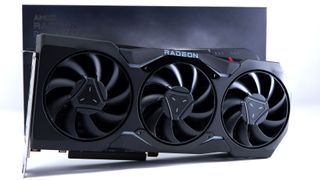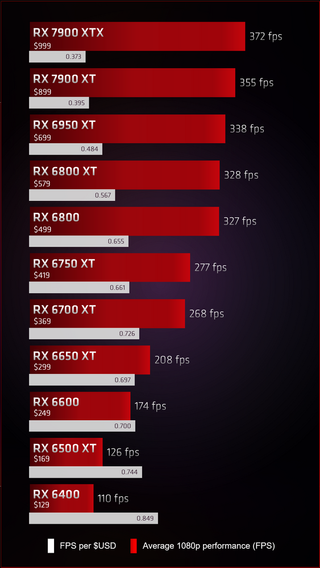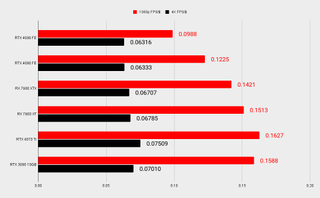AMD's new GPUs are pretty poor value according to...AMD
AMD blog post publishes damning data about the value of its own new GPUs.

AMD's latest graphics cards are very poor value according to none other than AMD. In a blog post purporting to explain why there's never been a better time to buy an AMD GPU, the company demonstrated exactly how bad the value proposition is from its latest RDNA 3 era graphics.
In a chart erroneously titled "Average 1080p Performance and $/FPS Across 6 Games", AMD's new Radeon RX 7900 XTX and RX 7900 XTX are shown delivering by far the worst returns in terms of FPS per dollar.
Both the RX 7900 XT and XTX deliver less than half the frames per dollar of AMD's best value GPU. Of course, those new RDNA 3 models are high-end boards. And the very best value is not typically to be found right at the top of a GPU range.
However, what makes really uncomfortable reading for AMD is just how badly the new RDNA 3 boards do compared with previous-gen RDNA 2 GPUs. The RX 7900 XTX delivers 0.373 frames per dollar and the RX 7900 XT 0.395 according to AMD's own numbers.
But the previous-gen Radeon RX 6800 nails 0.655 frames per dollar and even the 6950 XT returns 0.484 frames per dollar. Though if AMD had taken the original MSRP for the RX 6950 XT at its $1,099 launch price that would have been much worse than either of the RDNA 3 cards.
While it has become somewhat inevitable that new generation graphics hardware is more expensive, in our book it's an absolute no-no to get less performance for your money with new hardware. That's exactly the opposite of how technological progress is supposed to work.

Look elsewhere on the chart and it's no surprise to find that it's the Radeon RX 6700 XT that offers by far the best overall value proposition at 0.726 frames per dollar. The 6700 XT wasn't the strongest value play at launch, but at its current $369 price and with actual street prices in similar territory, it has really come in to its own and absolutely stands out in a market stuffed with offensively overpriced GPUs.
The biggest gaming news, reviews and hardware deals
Keep up to date with the most important stories and the best deals, as picked by the PC Gamer team.
For the record, AMD's fine print says the performance-per-dollar numbers in the published chart were based on a suite of games including Apex Legends, Valorant, Call of Duty: Modern Warfare 2, The Callisto Protocol, GTA V, and Overwatch 2. All GPUs were tested at 1080p max settings except RX 6400 at which was generously allowed the "Medium" preset and thus should effectively be ignored. The 0.849 frames per dollar it achieves according to AMD is very misleading.

On a similar note, our own benchmarking entirely concurs with AMD's figures. The RX 6700 XT is indeed the best value offering from AMD by far. But then if AMD's own carefully curated numbers were making the new RDNA 3 boards look like bad value, independent third-party testing is hardly likely to make for a better narrative.
It's also worth noting that looking at our own benchmark suite Nvidia's new Ada generation of graphics cards don't look any better. In fact both the RTX 4090 and RTX 4080 offer worse frames per dollar numbers than either AMD's latest GPUs when comparing our own internal numbers. Though the RTX 4070 Ti is, somewhat inevitably, the best-value card of the five new-gen cards released. If you can add the notional idea of 'value' to a $799 GPU.
All of which is to repeat a depressingly familiar narrative about PC graphics pricing. The situation stinks and we very much hope it improves soon.
Best CPU for gaming: Top chips from Intel and AMD
Best gaming motherboard: The right boards
Best graphics card: Your perfect pixel-pusher awaits Best SSD for gaming: Get into the game first

Jeremy has been writing about technology and PCs since the 90nm Netburst era (Google it!) and enjoys nothing more than a serious dissertation on the finer points of monitor input lag and overshoot followed by a forensic examination of advanced lithography. Or maybe he just likes machines that go “ping!” He also has a thing for tennis and cars.
Most Popular







